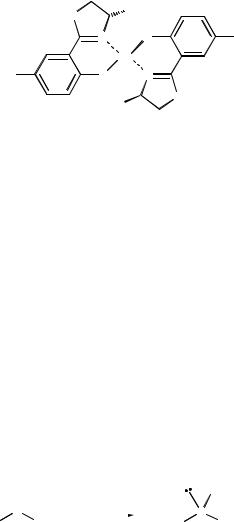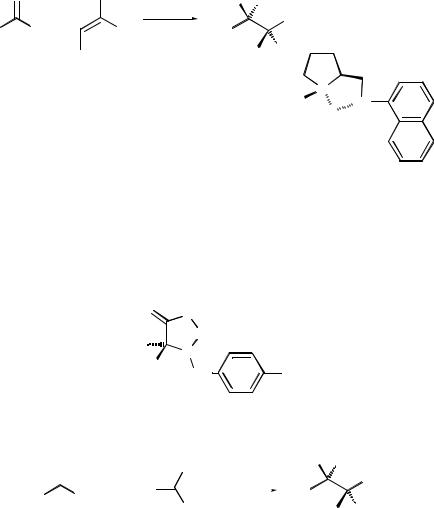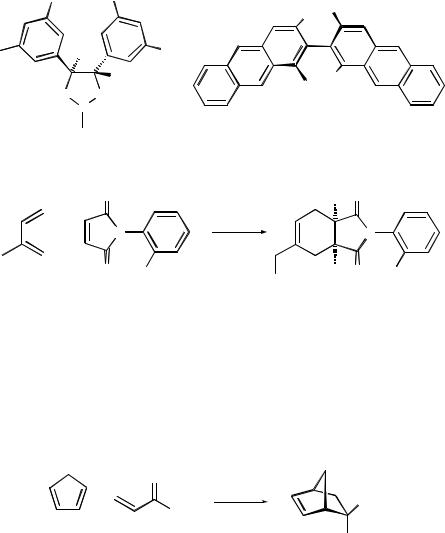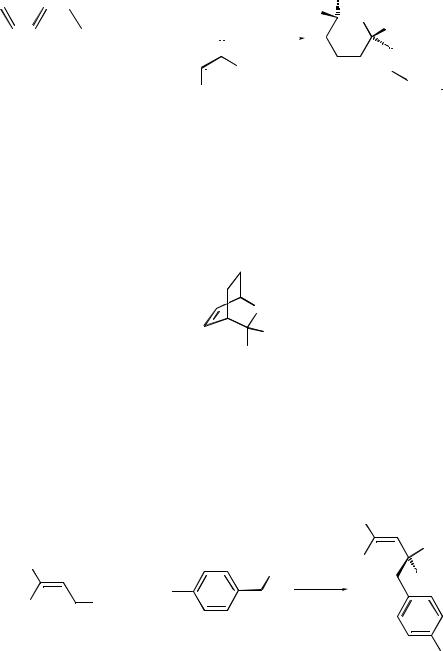
Roberts S.M., Poignant G. - Catalysts for fine chemical synthesis (Vol.1) (2002)(en)
.pdf
the integration of biotransformations into catalyst |
25 |
|||
|
O |
C(Me)3 |
|
|
|
|
|
|
|
|
N |
O |
NO2 |
|
|
|
Cu |
|
|
O2N |
O |
N |
|
|
|
(Me)3C |
O |
|
|
|
|
|
||
|
|
(35) |
|
|
pivaldehyde in benzene under an atmosphere of oxygen gives a high yield of the (S)-g-lactone but in only 44 % ee[105]. Similarly stereoselective oxidation of 3- hydroxymethylcyclobutanone has been accomplished with dialkyl tartrate/ titanium complexes and tert-butyl hydroperoxide (conditions similar to those
used in Sharpless asymmetric epoxidations). However, yields are modest and the enantiomeric excess of the (R)-lactone was just 75 %[106].
In contrast to the situation with the Baeyer±Villiger oxidation, synthetic chemists have a choice of both enzymatic or non-enzymatic methods for the oxidation of sulfides to optically active sulfoxides with good to excellent yields and enantiomeric excesses.
Thus a number of enzymes have been shown to be able to control the oxidation of sulfides to optically active sulfoxides; most extensive investigations have concentrated on mono-oxygenases (e.g. from Acinetobacter sp., Pseudomonas putida) and haloperoxidases[107] (from Caldariomyces fumago and Corallina officinalis). A comparison of the methodologies[108] led to the conclusion that the haloperoxidase method was more convenient since the catalysts are more readily available (from enzyme suppliers), the oxidant (H2O2) is cheap and no cofactor recycling is necessary with the haloperoxidases. Typical examples of haloperoxidase-catalysed reactions are described in Scheme 24.
|
|
|
|
|
O- |
|
|
S |
|
i |
S |
|
|
|
|
|
|
|
||
Me |
R |
|
Me |
+ |
R |
|
|
|
|||||
R=isopropyl, allyl, |
|
>98 % ee |
|
|||
|
pentyl,cyclopentyl |
|
75-98 % conversion |
|||
Scheme 24: Reactions and conditions: i) Chloroperoxidase from Caldariomyces fumago, H2O2, halide ion, H2O.
Of several procedures for the stereoselective oxidation of sulfides using organometallic complexes*, two adaptations of Kagan's original process have gained prominence. In the first method the diol (36) is reacted with Ti(Oi Pr)4 to form the catalyst. With cumyl hydroperoxide as the stoichiometric oxidant,
methyl para-tolyl sulfide was converted into the optically active sulfoxide in 42 % yield (98 % ee)[109].

26 |
hydrolysis, oxidation and reduction |
In the second noteworthy adaptation of the Kagan method, Reetz and coworkers utilized the dinitrooctahydronaphthol (37). Oxidation of methyl paratolylsulfide under similar conditions to those in the above paragraph furnished the optically active sulfoxide (86 % ee)[110].
|
|
|
NO2 |
|
|
|
NO2 |
|
|
H |
OH |
|
|
|
Me3C |
|
|
|
|
|
OH |
Me3C |
|
|
|
|
|
||
H |
OH |
OH |
OH N |
CMe3 |
|
|
|
||
Me3C |
|
|
|
H |
|
|
NO2 |
HO |
|
(36) |
|
(37) |
(38) |
|
In addition, a recent report details a very efficient nonenzymatic method for the asymmetric oxidation of sulfides; this employs an organo-vanadium species featuring the imine (38) (Scheme 25)[111]. A second, complementary strategy for the preparation of optically active sulfoxides involves the enantioselective oxidation of racemic sulfoxides.*
|
O |
S |
S |
Ph |
i |
Ph |
|
S |
S |
85 % ee
Scheme 25: Reagents and conditions: i) VO(acac)2 , compound (38), H2 O2 , H2 O, CH2 Cl2 .
1.4CARBON±CARBON BOND-FORMING REACTIONS
In the arena of carbon±carbon bond-forming reactions, obviously a central feature in synthetic organic chemistry, the number of nonbiocatalytic methods in regular use far outweighs the small portfolio of biotransformations that can be considered to be available for general employment.
Indeed the only conversion where biocatalysis should be seriously considered is the transformation of aldehydes into optically active cyanohydrins[112]. For example, the conversion of aryl aldehydes into the appropriate (R)-cyanohydrins using almond meal may be accomplished in quantitative yield and gives products

the integration of biotransformations into catalyst |
27 |
of high optical purity[113]. The method is much less successful for the vast majority of ketones.
(S)-Cyanohydrins are formed from a wide range of alkyl and aryl aldehydes (and also some methyl ketones) often in good yield and high enantiomeric excess using the enzyme (hydroxynitrile lyase) from Hevea brasiliensis[114]. The same range of substrates and the same cyanohydrins ((S)-configuration) are formed on catalysis of the addition of HCN using the hydroxynitrile lyase
from Manihot esculenta. This enzyme has been cloned and over-expressed in E.
coli[115].
A biomimetic method using a cyclic dipeptide (39) is available. In the
presence of HCN in toluene containing 2 mole% of (39), benzaldehyde is converted into the (R)-cyanohydrin in 97 % yield (97 % ee)[116].
|
|
N |
B r |
|
|
HN |
|
|
|
|
|
Br |
OH |
|
O |
H |
|
|
O |
N |
|
|
||
H |
|
|
||
Ph |
|
N |
N |
|
|
|
|||
|
|
|
|
|
H |
N |
O |
H |
CHMe2 |
H |
|
|||
|
(39) |
|
(40) |
|
Complexation of an amino acid derivative with a transition metal to provide a cyanation catalyst has been the subject of investigation for some years. It has been shown that the complex formed on reaction of titanium(IV) ethoxide with the imine (40) produces a catalyst which adds the elements of HCN to a variety of aldehydes to furnish the (R)-cyanohydrins with high enantioselectivity[117].
Other imines of this general type provide the enantiomeric cyanohydrins from the same range of substrates[117].
The addition of trimethylsilyl (TMS) cyanide to aldehydes produces TMSprotected cyanohydrins. In a recent investigation a titanium salen-type catalyst
has been employed to catalyse trimethylsilylcyanide addition to benzaldehyde at ambient temperature[118]. Several other protocols have been published which also
lead to optically active products. One of the more successful has been described
by Abiko et al. employing a yttrium complex derived from the chiral 1,3-diketone (41)[119] as the catalyst, while Shibasaki has used BINOL, modified so as to
incorporate Lewis base units adjacent to the phenol moieties, as the chiral complexing agent[120].
The aldol reaction is of fundamental importance in organic chemistry and has been used as a key reaction in the synthesis of many complex natural products. There are biocatalysts for this reaction (aldolases) and one (rabbit muscle

28 |
hydrolysis, oxidation and reduction |
O O
Fe
Me Me
Fe
(41)
aldolase, RAMA) has been quite widely used for the preparation of carbohydrates and closely related compounds. For example, the azidotetraol (42) (a precursor of novel cyclic imine sugars active as a-fucosidase inhibitors) has been prepared by coupling dihydroxyacetone monophosphate and 2- azido-3-hydroxypropanal using RAMA as the catalyst, followed by dephosphorylation (Scheme 40)[121].
|
O |
|
|
OH |
|
|
CH2 OH |
|
|
|
|
|
|
||
HO |
OPO |
2- |
|
CHO |
i |
|
OH |
+ |
|
O |
|||||
|
3 |
|
|
|
|
||
|
|
|
|
|
|
N3 |
OH |
|
|
|
|
|
|
HO |
|
|
|
|
|
N3 |
|
|
|
|
|
|
|
|
|
|
|
|
|
|
|
|
|
|
(42) |
Scheme 40: Reagents and conditions: i) RAMA, H2 O then dephosphorylation using acid phosphatase.
Other aldolases, from microorganisms, have been cloned and overexpressed. For instance, l-threonine aldolase from Escherichia coli and d-threonine aldo-
lase from Xanthomonus orysae have been obtained and used to prepare b- hydroxy-a-amino acid derivatives[122].
On moving away from carbohydrate chemistry one finds that non-natural catalysts are the materials of choice for the promotion of the classical aldol reaction and more recently-discovered variants. A wide range of methods are available and a small selection of these is described below.
One of the most widely studied aldol-type reactions is the Mukaiyama coupling of enol silanes of various types to aldehydes, catalysed by Lewis acids (notably organotin, organoboron, organotitanium and organocopper species). A typical example of the stereocontrolled coupling of an aromatic or aliphatic aldehyde and a silylthioketene acetal is described in Scheme 41. The products are generally obtained in 70±80 % yield with a good to excellent diastereo-
meric excess of the syn isomer in 90±100 % ee on using 10±30 mol% of the catalyst (43)[123].

|
the integration of biotransformations into catalyst |
29 |
|||
|
O |
OSiMe3 |
Me3SiO H |
|
|
|
|
|
|
|
|
|
+ |
|
i |
|
|
|
|
COSEt |
|
|
|
R |
H |
SEt |
R |
|
|
|
Me |
|
Me H |
|
|
|
|
|
N |
|
|
|
|
|
Me |
NH |
|
|
|
|
(TfO)2Sn |
|
|
|
|
|
(43) |
|
|
Scheme 41: Reagents and conditions: i) C2 H5 CN, ÿ 78 C, 10±30 mol% complex (43).
Of the catalysts that are based on boron, the Masamune oxazaborolidines
(44) are typical, being able to promote aldol reactions of the type described in Scheme 42[124].
O |
O |
|
BH |
|
Me |
|
N |
|
Aryl |
|
SO2 |
Me |
(44) |
|
|
O |
|
|
|
OSiMe3 |
HO H |
|||
|
|
|
|
|
|||||
|
|
|
|
|
|
|
CO2Ph |
||
|
|
|
|
|
+ Me2C |
|
|
i |
|
Ph |
|
|
|
H |
|
|
|
Ph |
|
|
|
|
|
|
|
||||
|
|
|
|
|
|
|
|
||
|
|
|
|
|
|
|
OPh |
Me Me |
|
|
|
|
|
|
|
|
|
|
|
|
|
|
|
|
|
|
|
|
98 % ee |
Scheme 42: Reagents and conditions: i) 20 mol% catalyst (44).
From the organotitanium family of catalysts BINOL±TiCl2 and BINOL±
Ti(i PrO)2 catalysts have been complemented by related catalysts of type (45) introduced by Carreira[125]. The simple enol silane (46) adds to a variety of
aldehydes in high yields and excellent enantiomeric excesses, using as little as 0.5 mol% of the catalyst (45). The reacting aldehydes can bear some other functional groups, such as tert-butyldimethyl silyl either moieties.

30 |
hydrolysis, oxidation and reduction |
|
|
|
||
|
|
Me |
Me |
|
|
|
N |
OSiMe3 |
O |
|
|
O |
|
|
|
|
|
|||
O |
O |
|
|
|
|
|
Ti |
O |
N |
N |
|
|
|
O |
OMe |
|
|
|||
|
|
|
|
|
||
|
H |
|
Cu2+ |
H |
||
But |
O |
|
||||
|
|
CMe |
3 |
X2 |
CMe |
3 |
|
|
|
|
|
||
tBu |
(47): X = CF3SO3- |
|
||||
(45) |
(46) |
(48): X = [SbF6]- |
|
|||
The utilization of copper complexes (47) based on bisisoxazolines allows various silyl enol ethers to be added to aldehydes and ketones which possess
an adjacent heteroatom: e.g. pyruvate esters. An example is shown is Scheme 43[126]. C2-Symmetric Cu(II) complexes have also been used as chiral Lewis
acids for the catalysis of enantioselective Michael additions of silylketene acetals to alkylidene malonates[127].
Me |
|
|
CO2Me |
OSiMe3 |
|
Ph |
CO2Me |
||||
|
|
|
|
+ |
|
i |
|
|
HO |
Me |
|
|
|
|
|
|
|
||||||
|
|
|
|
|
|
|
|
|
|||
|
|
|
|
|
|
|
|
|
|
||
|
O |
|
Ph |
|
O |
||||||
Scheme 43: Reagents and conditions: i) CH2 Cl2 , ÿ 78 C, 10 mol% catalyst (47).
Direct asymmetric aldol reactions, that is between aldehydes and unmodified ketones has been accomplished using a lanthanum trilithium tri(binaphthoxide) complex[128].
One of the key features of such stereocontrolled aldol reactions is the predictability of the absolute stereochemistry of the enantiomers (or diastereomers) that will be formed as the major products. The preferred intermediate for an archetypal aldol reaction, proceeding by way of a metal enolate, can be tracked using the Zimmerman±Traxler transition state and the results from the different variations of the aldol reaction can be interpreted from similar reasoning, and hence predictions made for analogous reactions[129].
The second well-known and much-used carbon±carbon bond forming reaction is a [4 ‡ 2]-cycloaddition, the Diels±Alder reaction. Very many chiral Lewis acid catalysts have been used to promote this reaction and a pot-pourri of organo-aluminium, -boron and -copper catalysts are described, in brief, below.
The first organoaluminium complex that catalysed a Diels±Alder reaction was formed from menthol and ethylaluminium dichloride. This finding was complemented by work of Corey who showed that the aluminium±diamine complex (49) was effective for controlling the stereochemistry of Diels±Alder reactions involving cyclopentadiene and acryloyl and crotonyl amides (e.g.

the integration of biotransformations into catalyst |
31 |
CH3CH ˆ CHCONR2). Later investigations showed the catalysts were also
effective stereocontrolling systems for the coupling of a maleimide to an acyclic diene (Scheme 44)[130].
Me |
Me |
|
|
|
Ph Ph |
Me |
H |
Me |
|
H |
HO |
|
|
OH |
CF3SO2N |
NSO2CF3 |
|
|
Al |
|
|
Me |
|
|
(49) |
(50) |
|
O |
|
H |
O |
|
+ |
N |
|
i |
|
|
|
|
N |
|
||
MeO |
O Me |
|
H |
O Me |
|
|
C |
C |
|||
|
3 |
|
MeO |
3 |
|
|
|
|
|
|
95 % ee
Scheme 44: Reagents and conditions: i) CH2 Cl2 , ÿ78 C, 10±20 mol% catalyst (49).
The biaryl compound (50) forms a complex with diethylaluminium chloride to provide a catalyst able to promote enantioselective reaction between cyclopentadiene and methacrolein or acrylates (Scheme 45). The addition of di-tert butyl 2,2-dimethylmalonate to the reaction mixture was found to enhance the enantiomeric excess of the product[131].
|
O |
|
+ |
i |
|
H |
||
|
||
|
OMe |
CO2Me
>99 % ee 76 % yield
Scheme 45: Reagents and conditions: i) (Me3 CO2 C)2 CMe2 50 mol%, Et2 AlCl and compound (51) 10 mol% each, CH2 Cl2 , ÿ78 C to ÿ 40 C.

32 |
hydrolysis, oxidation and reduction |
Acyloxyboron complexes and oxazaborolidines have been shown to catalyse Diels±Alder reactions featuring aldehydes as one component: for example, the
complex (51) allows the coupling of cyclopentadiene and a-bromoacrolein in high yield to give a product of high optical purity (Scheme 46)[132]. The
immobilized catalyst system of this genre, recently introduced by Itsuno, is
O |
O |
Bu |
O |
|
B |
O |
|
|
|
||
HN |
|
|
B |
N |
|
O |
|
|
|
||
|
H Tosyl |
OH |
|
|
|
||
(51) |
|
|
(52) |
|||
Br |
CHO |
i |
|
CHO |
||
|
||||||
|
|
|||||
+ |
|
|
|
Br |
||
|
|
|
|
|
||
|
|
|
|
|
|
|
|
|
|
|
|
|
|
|
|
|
||||
|
|
|
|
99 % ee |
||
|
|
|
|
95 % yield |
||
Scheme 46: Reagents and conditions: i) CH2 Cl2 , ÿ78 C, 5±10 mol% catalyst (51).
also worthy of note[133]. In a further development Brùnsted acid-assisted chiral Lewis acids such as compound (52) were shown to promote stereocontrolled reactions of dienes with a range of a, b-unsaturated aldehydes[134].
Copper(II)-bis(oxazoline) complexes (48) are robust, valuable catalysts for a wide variety of stereoselective Diels±Alder reactions. In a key step en route to
O
N P(a-naphthyl)2
H
 CMe3 Cu2+ (OSO2CF3)22-
CMe3 Cu2+ (OSO2CF3)22-
(55)

the integration of biotransformations into catalyst |
33 |
optically active cannabinols, Evans and co-workers showed that an acyclic
dienol ester combined with the amide (53) to give the cyclohexane derivative (54) (Scheme 47)[135].
|
|
|
|
H |
Me |
O |
O |
|
Me |
|
OAc |
|||
|
|
|
|
|
+ |
|
|
|
i |
OAc |
N |
|
O |
H |
|
|
N
O
O
(53) |
(54) |
O |
98 % ee
78 % yield
73 % exo addition
Scheme 47: Reagents and conditions: i) Compound (48) (2 mol%), CH2 Cl2 , ÿ20 C.
The phosphino-oxazoline copper(II) complex (55) has also been found to be an effective catalyst[136] as have some titanium complexes, such as the exten-
sively researched titanium±TADDOL system (56)[137]. A modified Ti(IV)± TADDOL compound is the catalyst of choice to promote Diels±Alder cycload-
dition reactions between cyclopentadiene and alk-2-enyl phenylsulfonylmethyl ketones[138].
Ph |
Me |
|
|
|
H |
O |
O |
|
H |
H |
O CO2Et |
Ph |
|
Ph |
Ph |
|
Ph |
O |
O |
|
|
Ti |
OCO(CH2)2CO-bovine serum albumin |
|
Cl2 |
|
|
(56) |
(57) |
The library of natural catalysts has very little to offer for the catalysis of Diels±Alder (and the reverse) reactions (Diels±Alderases)[139]. For this reason one of the intriguing areas of biomimickry, namely the formation and use of antibodies exhibiting catalytic activity, has focused on [4 ‡ 2] reactions to try to furnish proteins possessing useful catalytic properties. Thus in early studies a polyclonal catalytic antibody raised to hapten (57)[140] showed a modest rate enhancement for the reaction depicted in Scheme 48.

34 |
|
|
|
|
hydrolysis, oxidation and reduction |
|
|
|
|
|||||||||||
|
|
|
|
|
|
|
|
|
|
|
|
|
CO2Et |
|
|
|
|
|||
|
|
|
|
|
OCO(CH2)2CO2CH2Ph O |
|
|
H |
|
|
O |
H |
||||||||
|
|
|
|
|
|
|
||||||||||||||
|
|
|
|
|
|
i |
|
|
|
|||||||||||
|
|
|
|
|
|
|
|
|
|
|||||||||||
|
|
|
|
|
|
|
|
|
|
|||||||||||
|
|
|
|
|
|
|
|
|
|
|
|
|
|
|||||||
|
+ |
|
|
|
|
OEt |
|
|
|
|
|
OCO(CH |
|
2)2 |
||||||
|
|
|
|
|
|
|
|
|
|
|
||||||||||
|
|
|
|
|
|
|
|
|
|
|
||||||||||
|
|
|
|
|
|
|
|
|
|
|
|
|
|
|
|
|||||
|
|
|
|
|
|
|
|
|
|
|
|
|
|
|
|
|
|
|
||
|
|
|
|
|
O |
|
|
|
|
|
|
|
||||||||
|
|
|
|
|
|
|
|
|
|
|
|
|
|
|||||||
|
|
|
|
|
|
|
|
|
|
|
|
|
|
|
|
|||||
|
|
|
|
|
|
|
|
|
|
|
|
|
|
|
|
|
|
|
|
|
CO2CH2Ph
Scheme 48: Reagents and conditions: i) polyclonal antibody raised against hapten (57).
The same, understandable bias towards the preferred use of `man-made'
catalysts, rather than biocatalysts, continues in the area of hetero-Diels±Alder reactions[141]. For example, in the presence of 5 mol% of copper complexes of
the type (47), cyclohexadiene and ethyl glyoxylate produce the oxabicyclooctene (58) (66 % yield, 97 % ee)[142].
O
H
CO2Et
(58)
Asymmetric alkylation of enolates can be effected using chiral phase transfer reagents. In an example from O'Donnell's group, the ester (59) is alkylated in a two-phase solvent system containing an N-benzylcinchoninium salt (Scheme 49)[143]. Again, there is no competing methodology in the armoury of biocatalysis.
|
|
|
Ph |
|
|
|
|
|
CO tBu |
|
|
|
Ph |
2 |
Ph |
|
|
|
|
Br |
|
|
|
|
|
i |
|
H |
|
|
|
|
||
|
|
|
|
|
|
+ Cl |
|
|
|
Ph |
CO2tBu |
|
|
|
|
(59) |
|
|
|
|
|
|
81 % ee |
Cl |
|
|
|
|
Scheme 49: Reagents and conditions: i) 50 % NaOH, toluene and CH2Cl2, 5 C N- benzylcinchoninium salt.
